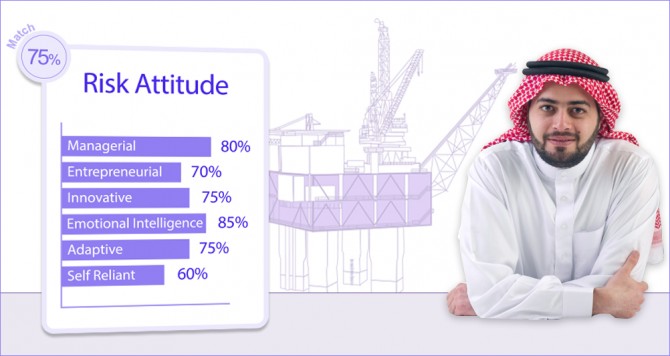
Assessing an employee’s risk attitude
Decision making & risk attitude
When building a team and selecting team members for a project, one needs to consider skills needed to compete the tasks. To further complicate things, you also need to consider attitudes of the team members and how their personalities will affect the decisions that they make.
All decisions have a risk element associated to it, and the quality of the decisions have a direct effect on the productivity of the project.
A new employee brings a new risk attitude
When building a productive team, it is beneficial to consider the risk attitude of team members, individually and collectively. This becomes particularly important when you are facilitating an initiative like Saudization (or Emiratisation) because when you are replacing an expat employee with a Saudi employee, you are introducing a new risk attitude to the team.
In Saudi, it is an open secret that companies prefer expats over Saudis because the majority of expats (especially at a junior level) show little resistance in following a prescribed corporate. The companies prefer expats because it decreases uncertainty to productivity. If asked to replace the expat with a Saudi, it creates a fear of not knowing how productivity will be affected. The uncertainty can be addressed if we use an assessment to visualize the difference in the risk attitude of individuals by assessing how they make their decisions. The following is a comparative illustration of a expat and a Saudi potential hire.
The opportunity in Saudization
We can look at Saudization as an opportunity to create a positive impact during a team building exercise.
We are encouraging companies to use customized assessments to visualize and understanding the different risk attitude of individuals and of the team. A customized assessments would measure decision making patterns in a select set of key work areas. Customized assessments are desirable because they localize the questions for each one of the key work areas. This increases the relevancy of the assessment.
As an example, let us consider a project where there is a limited budget, where the milestones are not clearly defined, and where the team members who come from highly diverse background (demographic and socio-demographic), In such a case, we would create a customized assessment catering to the following key work areas:
1. Everyday managerial responsibilities
2. Entrepreneurial trajectory
3. Innovative trajectory
4. Emotional intelligence when engaging non-Saudi team members
5. Adaptive nature to changes in the work environment
6. Self reliance in managing the delivery of a task
Once the assessment has been run, we can visualize the risk attitudes of one individual, or of the entire team. You can also conduct multiple baseline analysis and generate several types of comparative illustrations.
The following is a comparative illustration where a team depicted in 3 levels of management (x-axis), and is further divided into 3 risk categories (y-axis): High risk takers, Acceptable risk takers, and low risk takers.
.
If your company is moving towards implementing an effective plan for Saudization, then do consider how to use risk attitude analysis to help you reach your productivity goals.
Author:
Saleem Qureshi | CEO at Assessment Fund
Saleem@AssessmentFund.com
From the desk of
Fatal error: Uncaught Error: Call to undefined function get() in /home4/hirelabs/public_html/saleemqureshicom/wp-content/themes/wpex-fabulous/single.php:260 Stack trace: #0 /home4/hirelabs/public_html/saleemqureshicom/wp-includes/template-loader.php(106): include() #1 /home4/hirelabs/public_html/saleemqureshicom/wp-blog-header.php(19): require_once('/home4/hirelabs...') #2 /home4/hirelabs/public_html/saleemqureshicom/index.php(22): require('/home4/hirelabs...') #3 {main} thrown in /home4/hirelabs/public_html/saleemqureshicom/wp-content/themes/wpex-fabulous/single.php on line 260


